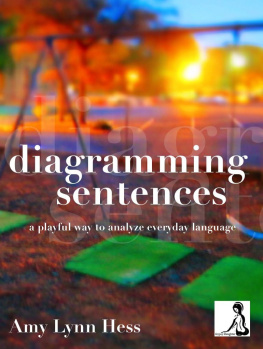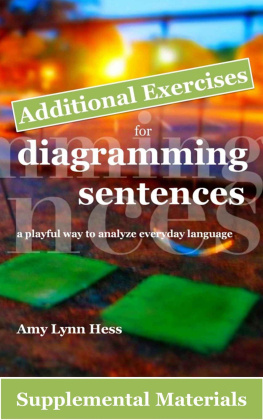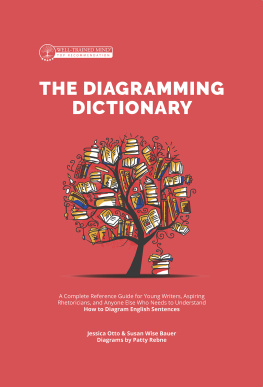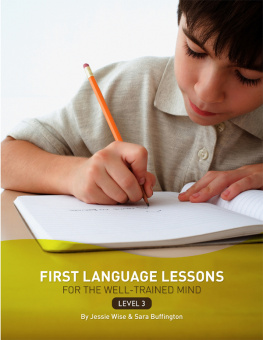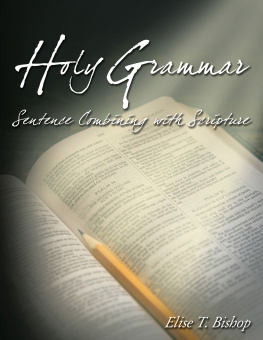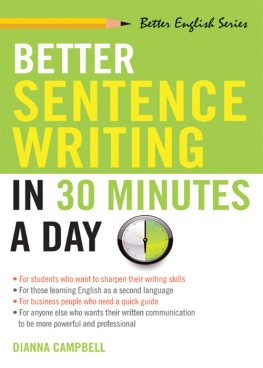All rights reserved. No part of this publication may be reproduced or transmitted in any form or by any means, electronic or mechanical, including photocopy, recording or any information storage and retrieval system, without permission in writing from the author.
Introduction
Why Learn to Diagram Sentences?
Diagramming sentences is a great way for kinesthetic learners to learn about grammar with a hands-on approach. It's also perfect for visual learners or those who learn by seeing patterns, charts, graphs, and diagrams. From a pedagogical or andragogical standpoint, sentence diagrams are one of the most thorough and concrete methods for assessing very specific grammatical knowledge. For students and teachers both, this means more personalized diagnostic testing and more meaningful lesson planning.
In addition to helping isolate specific points of grammar and sentence construction, the basic repetitive principles of diagramming can be applied to any sentence as a way to help unravel the meaning of that sentence. This, then, leads to better and more thorough reading comprehension skills.
It follows that if a person practices analyzing the sentences that other people write or say, and that person gets good at understanding what makes a sentence make good sense, then the sentences the diagrammer writes or says will start making more sense, too. In other words, diagramming makes writers better writers and critical thinkers.
What is Diagramming?
As stated above, diagramming is a systematic, repetitive process that can be applied to individual sentences as a way to unravel the meaning of that sentence. It helps visual learners learn to see the patterns in grammar. It gives kinesthetic learners an activity with a set of step-by-step guidelines for analyzing language. It allows all students to learn what makes sentences effective sentences.
Most importantly, it is a process that slows writing down and makes writers truly think about language.
What is a Sentence?
As there is no one-to-one correlation between any thought and any set of words used to express the thought, we cannot truthfully define a sentence as a complete thought. We can, however, define a sentence as a close representation of a complete thought . The closer to our thoughts we can make our sentences, the more effectively we communicate.
More pragmatically, we can define a sentence as a group of words, properly punctuated, that contains a subject and a verb and makes a complete thought (not necessary a one-to-one correlation to our exact complete thought).
There are several bits and pieces of language we use to express our thoughts each and every day. Some of those bits and pieces are parts of speech, and others are parts of a sentence. There are eight parts of speech: nouns, pronouns, adjectives (including articles), adverbs, verbs, conjunctions, prepositions, and interjections. There are five parts of a sentence: subjects, predicates, clauses, phrases, and modifiers.
W ith a basic knowledge of just those thirteen bits and pieces, we can begin diagramming sentences.
Chapter One - Simple Subjects and Verbs
Do you remember the rule that every sentence must have a subject and a predicate? Without either one of those parts of a sentence, a sentence is not really a sentence. However, there are a whole host of bits and pieces we can include in a sentence that will make a sentence more specific and more interesting. Those bits and pieces are parts of speech and parts of a sentence. Every word in a sentence can be labeled as one of the parts of speech, and every word or group of words in a sentence can be labeled as having a specific function within the sentence. For example, we can identify the subject of a sentence, and by calling it a subject, we are identifying its function in the sentence. When that same subject is a noun or pronoun, noun or pronoun is that words part of speech.
There are eight main parts of speech and five main parts of a sentence.
Parts of Speech. | P arts of a Sentence. |
Noun | Subject |
Pronoun | Predicate |
Adjective (including Articles) | Clause |
Adverb | Phrase |
Verb | Modifier |
Conjunction |
Preposition |
Interjection |
When we mix and match these eight parts of speech with the five parts of a sentence, we come up with a whole host of units of meaning. For example, we have prepositional phrases, adverbial phrases, object pronouns, subject pronouns, verbals, direct objects, indirect objects, predicate adjectives, object complements, and a whole host of bits and pieces.
The parts of speech well cover in this first chapter are nouns, pronouns, and verbs. The parts of the sentence we'll cover in this first chapter are subjects and predicates. Take a look at the following table for an explanation of nouns, pronouns, and verbs.
Parts of Speech - Nouns, Pronouns, Verbs
Part of Speech | Definition | Examples |
Nouns | A noun is a person, place, thing, or idea. Nouns can be singular or plural, and nouns can be common or proper. | The nurses took a sample . Stanley went to London on business . Love is the greatest power in the world . |
Pronouns | A pronoun is a word that stands in for a noun. | Someone took this . He went home for that . It 's the greatest power in the world. |
Verbs | A verb shows action or a state of being. | The nurses took a sample. Stanley went to London on business. Love is the greatest power in the world. |
Parts of a Sentence
In addition to the parts of speech, there are five parts of a sentence. The two essential parts of a sentence are the subject and the predicate. If either the subject or the predicate of a sentence is missing, the sentence isnt really a sentence.
The Subject
- A subject is one of the two required parts of a sentence.
- A subject is a noun or pronoun (or a word or group of words that acts like a noun or a pronoun).
- A subject is the who or what in the sentence that does something or is something.
Examples of Subjects
In order to find the subject of a sentence, think about the who or the what in the sentence that does something or is something. The subject will always be a noun or a pronoun (or a word or group of words that acts like a noun or pronoun). In order to find the subject, ask Who? or What? plus the verb. The answer to your question will be the subject. In the analysis of the following examples, the subjects are in bold.
Finding the Subject of a Sentence
Sentence s | Question s | Subject s |
I love boats. They float. | Who loves? What floats? | I love. They float. |
Sailors sail. | Who sails? | |

